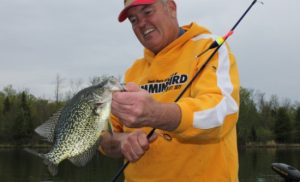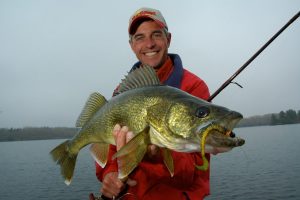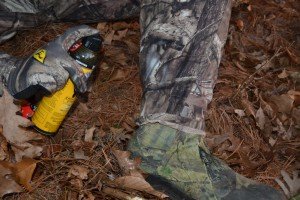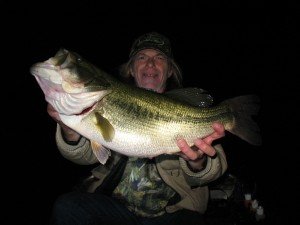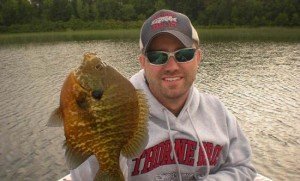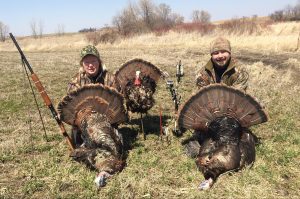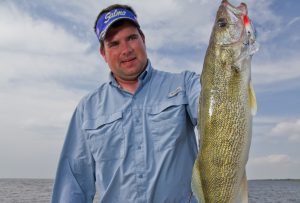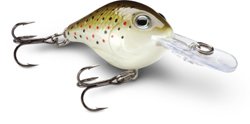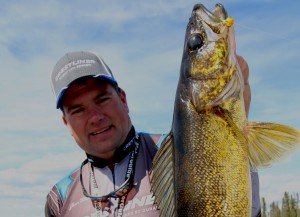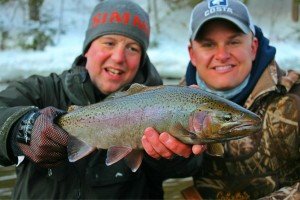Taking on big slab sided crappies is a respectable challenge and can be a real gas when you put it all together. Catching early season crappies is simple and easy enough but we’re talking real slabs (those in the thirteen to fifteen inch and beyond range), and they’re not everywhere. But the fact is they do exist and they can be caught if you have a little inside information. When it comes to producing behemoth crappies less is usually more. The lakes that hold big numbers are more likely to produce smaller fish. Probably big enough to put in the pail and that’s perfectly fine, but were not looking for the run of the mill keepers here. Our target is the largest of the species and it’s the lakes that have fewer fish that harbor the real monsters. Some of the best include medium to clear ... [ Read More ]
Catch the early season Rainy River walleye bite
Winter’s demise signals the beginning of an annual rite of spring, as schools of pre-spawn walleyes surge upstream into rivers across the Walleye Belt. Although the water is cool and fish location often changes day by day - even hour by hour - savvy anglers can enjoy some of the year’s best fishing, especially where rivers flow into larger bodies of water, such as the Rainy River at Lake of the Woods or Detroit River at western Lake Erie. In these situations, these Rainy River walleye from the main lake gather at the river mouth in late winter, then move upstream toward spawning areas as the ice recedes, boosting the river’s walleye population to its highest point of the year. I typically start my search at the river mouth and work my way upstream, checking channel edges and a variety ... [ Read More ]
Tick protection: creepy crawlies giving you the heebie-jeebies?
It's about more than just that skin-crawling sensation when you feel those little insect legs creeping up inside your pants or down your neckline; ticks and other biting insects can pose a real health concern. Addressing biting insect and tick protection as part of your hunting and outdoor activity prep is vital to avoid a multitude of diseases. Throughout human history, mosquitoes carrying disease have killed way more people than any war or natural disaster combined. And even with our modern medical technology, we're still not out of the woods yet. In my home state of Michigan, ticks currently carry Lyme Disease, as well as Rocky Mountain Spotted Fever, Tularemia, and Ehrlichiosis to name a few. Mosquitoes carry the West Nile Virus in the US as we speak. In Africa, Malaria spread by ... [ Read More ]
Getting A Grip On Transitional Bass
Getting A Grip On Transitional Bass When pertaining to giant bass in transitional modes, we need to take into consideration, not only the movements and transitions that bass make season within season. Daily transitions also occur throughout each season within season through the entire year. Lets first breakdown the seasonal transitions and then cover all aspects of variables that cause daily or nightly transitions within these stages of each particular season. The first seasonal transition occurs during the late Winter / Early Spring time frame, as the largest fish in the system migrate from Wintering areas in main lake basins following migration routes to eventual secondary staging zones. Consecutive fronts during this time frame create a scenario where giant bass will stall, ... [ Read More ]
Go Small or Go Home
Modern day society continues to push the mentality of doing things “big” and bold. “Go big or go home” is no longer just a term used on the sports field, but also rather in the office, at the factory, or even in the classroom. We are wired to take things to the max and “push it to the limit.” But what about fishing? Or better yet, what about those first few weeks after ice-out when the panfish are still in “ice mode” trying to find their appetite? “Go big or go home” might send you off with the latter, but “go small or go home” could be the ticket to an amazing day on the water. So what does “ Go Small or Go Home ” mean exactly? For me, it means keeping you ice fishing tackle with you when you first hit the open water scene. When you sit back and think about it, you just finished ... [ Read More ]
Turkey Patterning Tips
Now that the weather is starting to warm up and spring is here, a turkey hunter's thoughts turn towards chasing turkeys. It's often a lot of work to get that big tom into shotgun range. On top of that - these birds are tough to put down! You want to do everything in your power to make sure that when the opportunity presents itself that you're able to get the job done quickly and cleanly. Turkey patterning is probably the least fun part of turkey hunting. These turkey loads pack a wallop! But it is an important duty of yours as an ethical turkey hunter to do what you can to make a clean kill. Here are a few tips to get you started and make the process more efficient. Guns: Most people who hunt turkeys do not have a customized turkey gun. Rather, most use guns that they already use to ... [ Read More ]
Jigging for walleye Ten Tips to Catch More Walleyes with Jigs
By Jason Mitchell Jigging for walleye the most versatile method in any walleye fishing technique guid, and jigs are the most versatile tool in angler’s tackle box. Like any technique, In walleye jigging there are details and nuances that can make you successful or unsuccessful. If there is one aspect of jig fishing that is often overlooked, it would be the importance of versatility. There is not necessarily a right or wrong way to fish a jig. When the fish are biting, you can fish a jig in a lot of different ways and get bit. When conditions get tougher however, we often see a particular stroke or jigging style produce and catching fish is all about locking into that specific mojo. The best jig anglers can tap into that mojo. The cadences and strokes can vary ... [ Read More ]
Weighty Tips for Fishing Ultra-Lite Crankbaits
by Mitch Eegan They glitter. Shine. Shimmer in the light. Minuscule minnows and young-of-the-year fishes are everywhere. Deep, shallow, swimming amongst the thickest cover, suspended high in the water column or bellied to bottom. The fact is there are more of these tiny tidbits swimming about lakes, reservoirs and rivers than any other species with scales. While there are still days the old adage “big lures catch big fish” holds true, the fact of the matter is the opposite is more often spot on. Over all, little fishes are what larger fish eat; the reality being all sizes and species feast on bite-size prey over the hefty ones every day. This premise drives the recent explosion of micro crankbaits hitting the stores. The devil is in their details - external scales, realistic ... [ Read More ]
Reading fall walleye structure
During late summer and fall, if walleye are present, they are going to show up on electronics. Favorite fall walleye structure is rock reefs, deep points and classic structure that is between fifteen and forty feet of water - you are going to see fish on the screen. Bare spots that are void of life are usually a waste of time. No arches, no clutter, no bumps on the bottom - this often means no activity. Fishing this time of year is often very methodical and calculated. You have to trust your electronics and put yourself into position to be successful. Find the right fish and wait them out. Usually, when the marks start to lift off the bottom and separate, those are your active fish and that is your window to strike. This entire strategy however will unravel if you spend the entire ... [ Read More ]
Winter Trout in Minnesota
Effective winter patterns to consider trying for the season on selected streams predominantly include nymph patterns. The trout become lethargic in the cool winter moths and try to expend as little energy as possible. With water temperatures hovering between 34-40 degrees for most of the winter, trout will not chase their food down, but will suck it in as it floats by. That is why nymph patterns are so effective. Several nymph patterns are effective for southeastern Minnesota. The basic pattern is the scud, or freshwater shrimp in an orange or yellow color usually tied on a size 14-16 curved nymph hook. I usually use this pattern as my main nymph and tandem rig it with a dropper fly (the traditional two fly system). The scud is effective because of its color and appearance, not to mention ... [ Read More ]
